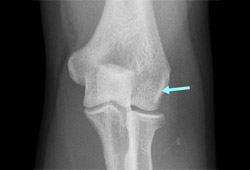Investigations
1st investigations to order
no initial tests (clinical diagnosis)
Test
Investigations are not indicated in the diagnosis of epicondylitis.
Tests are only performed if other causes need to be excluded.
Result
lateral epicondylitis: tenderness present 1 cm distal and anterior to the midpoint of the lateral epicondyle; medial epicondylitis: tenderness present distal and lateral to the medial epicondyle
Investigations to consider
elbow x-ray
Test
This test is reserved for patients with complex presentation (e.g., where history and examination findings are not typical or clear). [Figure caption and citation for the preceding image starts]: AP radiograph of elbow with lateral calcification from chronic lateral epicondylitisFrom the collection of Daniel J. Solomon, Naval Medical Center San Diego, CA; used with permission [Citation ends].
Result
calcification within the common extensor/flexor mass present in up to 20% of patients
computed tomographic scan of the elbow
Test
This test is reserved for patients with complex presentation and may demonstrate other pathology such as intra-articular loose bodies or osteoid osteoma.
Result
normal
MRI of the elbow
Test
This test is reserved for patients with complex presentation (e.g., where history and examination findings are not typical or clear).[46][Figure caption and citation for the preceding image starts]: Coronal MRI and axial MRI in the same patient, showing high signal in extensor carpi radialis brevisFrom the collection of Daniel J. Solomon, Naval Medical Center San Diego, CA; used with permission [Citation ends].
Result
increased signal within the tendon of the extensor carpi radialis brevis or pronator
MRI of the cervical spine
Test
This test is reserved for patients with complex presentation and associated evidence of radiculopathy.
Cervical MRI should be considered for patients who do not have a conclusive history and physical examination for epicondylitis, to investigate cervical radiculopathy as a cause for symptoms.[4][42][43]
Result
normal
electromyogram and nerve conduction studies
Test
This test is reserved for patients with complex presentation, including sensory deficit and/or motor weakness.
Although usually normal in epicondylitis, it may demonstrate increased latency across the elbow affecting the radial or ulnar nerves if there is a concurrent neurological condition.
Result
normal
ultrasound of the elbow
Test
This test is reserved for patients with complex presentation (e.g., where history and examination findings are not typical).[47]
Accuracy may be dependent on a number of variables.[45] Operators should be qualified practitioners in detection of abnormal musculoskeletal ultrasound findings.[44]
This test may be combined with therapeutic injections.[48]
Result
hypoechogenicity and bone changes indicate presence of a stressed common extensor origin-lateral epicondyle complex
Use of this content is subject to our disclaimer